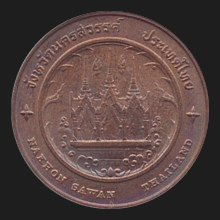|
Nakhon Sawan (นครสวรรค์)
Thai.
‘Heavenly
City’. Large capital of a province (map)
of the same name in Central Thailand and with a population of approximately 107,000 and
a substantial Chinese community. It is situated at
the foot of the hilltop temple Wat Chom Khiri Nak Phrot, around 240 kms North of
Bangkok at the confluence of the rivers
Ping,
Nan,
Yom and
Wang, that form the
Chao Phrya River. The town is known for its exuberant Chinese New
Year festival and the province is largely covered by the enormous Bung Boraphet
lake that stretches from Ban Laem
Nang So Nai in the West to Ban Phanom Set Nua in the East, and is a bird
sanctuary (fig.).
Historians assume that Nakhon Sawan first appeared during the
Dvaravati period as a royal city (rajathani
- ราชธานี) called Meuang Phra Bang (เมืองพระบาง).
During the
Sukhothai period, it was part of
the Sukhothai Kingdom, forming its southern frontier and remained an
important strategic city during the
Ayutthaya and
Thonburi
periods, up to the
Rattanakosin period, when it was
renamed Meuang Chon Tawan (เมืองชอนตะวัน).
Eventually its name was changed into the present Nakhon Sawan and
today the 4th Infantry Regiment of the 3rd Area Army is still based
here. The local population however refers to the city as Meuang Pahk
Nahm Phoh (เมืองปากน้ำโพ), a corruption
of the name Pahk Nahm Phloh (ปากน้ำโผล่),
which means ‘Emerging River Mouths’, referring to its location at
the confluence of the rivers Ping, Wang, Yom and
Nan. Besides a key
military outpost, its location made it also an important trade
centre, from the Ayutthaya period to the Rattanakosin period,
especially when King Rama IV signed the Bowring Treaty with Britain,
after which it became the main
rice
and teak trading centre. Its
importance, however, declined after the opening of the northern
railway in 1922, the economic crisis prior to the 1932 revolution,
as well as the construction of the Dejativongse bridge and
Phahonyothin highway in 1950, which decreased the importance of
transportation over waterways, making Nakhon Sawan less important. The province has 13
amphur and two
king
amphur. Its places of interest include
Bung Boraphet
lake, Uthayaan Sawan public park (map
-
fig.),
and
the large
Ganesha
statue at the Ganesha Idol Park, known in Thai as
Thevasataan Uthayaan Phra Phi
Kaneht
(map
-
fig.).
See also
Nakhon Sawan data file. 回






|

